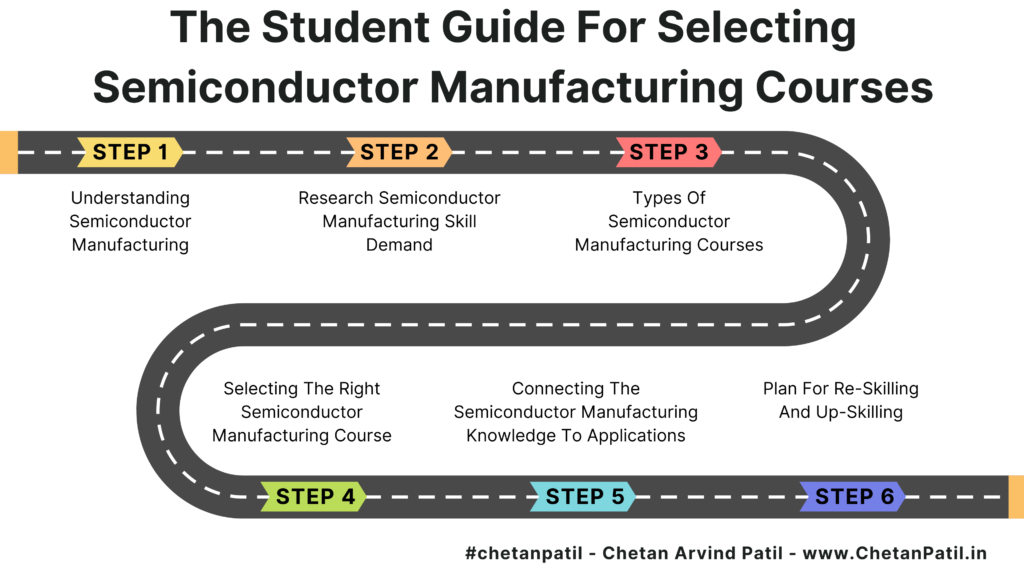Image Generated Using DALL-E
Why Semiconductor Manufacturing
The semiconductor industry is the backbone of modern technology, powering everything from smartphones to advanced computing systems. In 2022 alone, the global semiconductor market was valued at over $500 billion and projected to reach $1 trillion by 2030, driven by advancements in artificial intelligence and edge devices.
As the semiconductor industry continues to expand rapidly, the need for skilled professionals in semiconductor manufacturing is becoming increasingly urgent. A Semiconductor Industry Association (SIA) report predicts that the sector will require an additional 1 million skilled workers by 2030 to keep up with production and innovation demands, presenting a significant opportunity for those considering a career in this field.
Below is the guide for students approaching the available semiconductor manufacturing courses, helping them make informed decisions about their education and career paths.
STEP 1: Understanding Semiconductor Manufacturing
Before taking specific courses, students must have a solid understanding of semiconductor manufacturing. This step provides the foundational knowledge necessary to grasp the complexity and precision involved in creating semiconductor devices.
Semiconductor manufacturing includes photolithography, etching, doping, and packaging, each requiring high accuracy and technological expertise. By comprehending these fundamental processes, students can better appreciate the intricate work behind the chips that power modern technology.
Resources such as textbooks, online courses, and industry publications are excellent starting points for building this foundational knowledge. Additionally, understanding the historical evolution of semiconductor manufacturing, from the invention of the transistor to the development of modern microprocessors, can provide context and highlight the industry’s innovative nature.
While understanding the historical context is important, it is equally vital for students to familiarize themselves with the industry’s current state. This includes knowing the major players, significant technological advancements, and ongoing research and development efforts. This broad overview will equip students with the necessary background to make informed decisions about their education and career paths in semiconductor manufacturing.
STEP 2: Research Semiconductor Manufacturing Skill Demand
Understanding the demand for specific skills in semiconductor manufacturing is the first critical step for any student considering a career in this field. The semiconductor industry is highly dynamic, with continuous advancements requiring new competencies and expertise. By researching the current and future skill demands, students can align their educational pursuits with market needs, increasing their employability and career prospects.
Students should start their journey by delving into the wealth of industry reports, such as those published by the Semiconductor Industry Association (SIA) or consulting firms like McKinsey & Company. These reports provide invaluable insights into emerging trends and technologies, equipping students with the knowledge they need to make informed career choices and stay ahead of the curve.
Example Of Skill Demand Analysis: High-demand skills include expertise in photolithography, chemical vapor deposition (CVD), and atomic layer deposition (ALD). Additionally, knowledge of advanced packaging technologies like 2.5D and 3D integration is increasingly valuable. According to industry reports, there is a growing need for professionals who can work with emerging materials and fabrication techniques.
Pinpointing high-demand skills is a great start, but it is about more than just the skills. It is about understanding the context and real-world applications. To truly immerse yourself in the semiconductor manufacturing world, engaging with industry professionals is essential. Seminars, webinars, and professional organizations are a goldmine of insights into skill requirements, and they also provide a sense of community and connection, making you feel part of something bigger.
It is crucial to stay updated with the semiconductor industry’s ever-evolving needs. One effective way to do this is by exploring job postings and internship opportunities, which can provide a clear understanding of the qualifications and experiences employers seek. This foundational research can guide course selection and assist students in building a robust and relevant skill set.
Lastly, the prospects of skills are also significant. The future of semiconductor manufacturing will likely see a greater emphasis on sustainability and energy efficiency. Skills in developing low-power semiconductor devices and sustainable manufacturing practices will be highly sought, opening up a world of possibilities. Furthermore, the rise of quantum computing and neuromorphic engineering presents new opportunities and challenges, requiring a new generation of semiconductor experts.

STEP 3: Types Of Semiconductor Manufacturing Courses
Once students have a solid understanding of semiconductor manufacturing, the next step is to explore the various courses available. This section will guide students through different specializations within the field, each offering unique career opportunities.
Courses in fabrication (fab) processes cover essential manufacturing techniques, while design and simulation courses focus on creating and optimizing semiconductor circuits. Packaging and testing courses delve into the final stages of production, ensuring device reliability and performance.
Below is the information in a table format for better presentation. This table format provides a clear and organized presentation of the different types (limited list) of semiconductor manufacturing courses, along with their content, skills acquired, and related career opportunities, ensuring you can easily navigate and understand the information, and feel at ease in your decision-making process.
| Course Type | Course Content | Skills Acquired | Career Opportunities |
|---|---|---|---|
| Fabrication (Fab) Process Courses | Photolithography, chemical vapor deposition (CVD), etching, doping, planarization | Cleanroom protocols, process optimization, equipment operation | Process engineer, equipment technician |
| Design And Simulation Courses | VLSI design, CAD tools, simulation techniques | Circuit design, system simulation, CAD tool proficiency | Design engineer, CAD tool specialist |
| Packaging And Testing Courses | Packaging technologies, thermal management, reliability testing, failure analysis | Packaging techniques, thermal management, reliability analysis | Packaging engineer, test engineer |
| Material Science And Semiconductor Physics Courses | Material properties, semiconductor physics, crystallography, material characterization, quantum mechanics | Material properties analysis, device physics, advanced characterization techniques | Material scientist, device physicist |
| Equipment Courses | Equipment calibration, process control, integration of tools in production line | Equipment operation, maintenance, troubleshooting, process control | Equipment engineer, field service engineer |
| Data Analytics Courses | Statistical process control, yield analysis, machine learning for predictive maintenance, big data applications | Data collection, analysis, interpretation, use of data analytics tools | Data analyst, data scientist |
| New Device Development Courses | Emerging materials, device architecture, novel fabrication techniques, innovative applications | Design and development of new devices, experimental testing, application of new technologies | Research and development engineer, innovation specialist |
| Silicon Wafer Courses | Crystal growth, wafer slicing, polishing, defect analysis, types of silicon wafers | Silicon wafer production, quality control, defect detection and analysis | Wafer process engineer, quality control specialist |
| Clean Room Management And Safety Courses | Cleanroom design, contamination control, safety protocols, emergency procedures | Cleanroom management, safety compliance, contamination prevention | Cleanroom manager, safety officer |
Material science and semiconductor physics courses provide a deep dive into the properties and behaviors of semiconductor materials. Additionally, courses in equipment operation, data analytics, new device development, silicon wafer processing, and cleanroom management and safety offer specialized skills tailored to specific industry needs.
Understanding the content, skills acquired, and career opportunities associated with each type of course is crucial. However, it is equally essential for students to consider their interests and strengths. This comprehensive overview is a guide and a compass that can help students navigate the semiconductor industry’s vast landscape, identify the most relevant and valuable courses for their career aspirations, and reduce confusion in course selection.
STEP 4: Selecting The Right Semiconductor Manufacturing Course
Choosing the right semiconductor manufacturing course is a crucial decision that can significantly impact a student’s career trajectory. This step involves assessing personal interests, strengths, and career goals to select courses that offer the best fit.
Students should consider their passion for specific aspects of semiconductor manufacturing, whether it’s hands-on fabrication, theoretical design, material science, or data analytics. Evaluating industry demand and trends is also essential. Selecting courses aligned with high-demand skills ensures better job prospects upon graduation.
Students should research institutions and programs, prioritizing those with solid reputations and accreditation, as these often provide superior education quality and networking opportunities. Additionally, seeking advice from academic advisors, industry professionals, and alums can provide valuable insights into the best courses and institutions.
By carefully evaluating these factors, students can make informed decisions that enhance their educational experience and prepare them for successful careers in the semiconductor industry. This step ensures that students gain relevant knowledge and skills and position themselves strategically in a competitive job market.
STEP 5: Connecting The Semiconductor Manufacturing Knowledge To Applications
Applying semiconductor manufacturing knowledge in real-world scenarios is critical for career success. This step encourages students to bridge the theoretical learning and practical application gap. Courses often provide foundational knowledge, but applying this knowledge in industry settings through internships, projects, and hands-on training is invaluable.
Real-world applications of semiconductor manufacturing knowledge are not just about developing new devices, optimizing processes, or implementing quality control measures. They are about students seeing how their skills, honed through theoretical learning and practical experiences, contribute to innovative solutions and technological advancements. Networking and industry events further enrich their understanding of the current challenges and opportunities in semiconductor manufacturing.
Studying case studies and success stories of professionals in the field is a valuable source of inspiration and guidance for students. This step underscores the importance of experiential learning and continuous professional development. It equips students with the necessary tools to tackle real-world problems and contribute meaningfully to the semiconductor industry.
STEP 6: Plan For Re-Skilling And Up-Skilling
The semiconductor industry is continuously evolving, and staying relevant requires a commitment to lifelong learning. This step focuses on planning for re-skilling and up-skilling to keep pace with technological advancements. Students and professionals should regularly assess their skill sets, identify gaps, and seek further education and training opportunities.
This might involve taking advanced courses, obtaining new certifications, or attending workshops and seminars. Many semiconductor companies offer training programs to help employees stay updated with the latest technologies and practices. Additionally, online platforms and educational institutions provide flexible learning options that can accommodate busy schedules. Networking with peers and industry experts, joining professional organizations, and participating in industry conferences can also enhance learning and professional growth.
Students can ensure they remain competitive and valuable assets in the semiconductor industry by developing a long-term career development plan that includes goals for acquiring new skills and knowledge. This proactive approach to continuous learning is not just a necessity, but a powerful tool for adapting to the ever-changing landscape of semiconductor manufacturing, inspiring you to take charge of your professional journey.
Take Away
Ultimately, the semiconductor manufacturing field offers many opportunities for students. By understanding the different types of courses available and conducting a thorough self-assessment of their interests and strengths, students can make informed decisions that are in perfect harmony with their career goals.
Students should always research first and then enroll in relevant semiconductor manufacturing courses that match their career aspirations.





